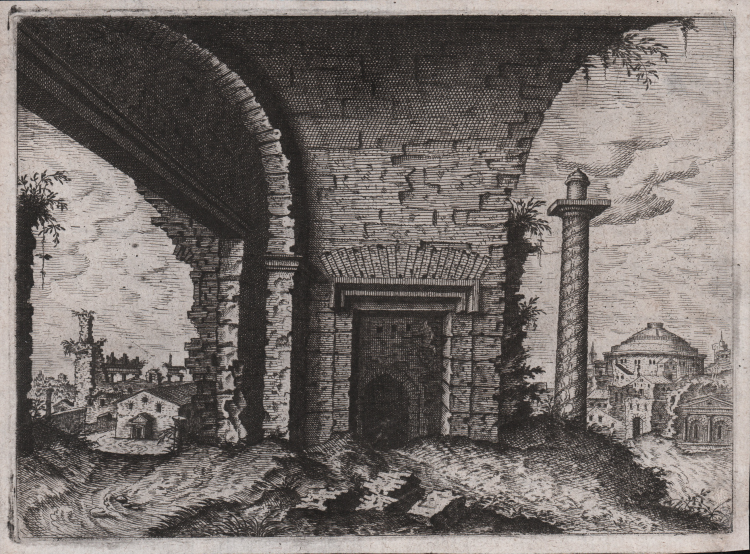




| Reference: | S45950 |
| Author | Johannes van DOETECUM |
| Year: | 1562 |
| Measures: | 215 x 155 mm |



| Reference: | S45950 |
| Author | Johannes van DOETECUM |
| Year: | 1562 |
| Measures: | 215 x 155 mm |
View of Roman ruins with the bottom of an arch, the Pantheon and column of Trajan at right, a figure seen in a doorway at centre; first state before number; possibly after Hieronymus Cock.
Etching and engraving, 1562, without signature.
This is one of a series of twenty-one views from Operum Antiquorum Romanorum hinc inde per diuersas Europae Regiones extructorum Reliquias ac ruinas saeculis omnibus suspiciendas non minus vere quam pulcerrime deformatas libellus his novus continent, etched by Johannes and Lucas van Doetecum. This series was first published by Hieronymus Cock in Antwerp in 1562 than Frederick de Wit later published a numbered series.
“Further research may possibly show that one or the other of the unidentified ruins also lie outside Rome and possibly outside Italy. The problem of identification is complicated by the attractive and not particularly realistic representation of the views referred to in the titles, which can be attributed to the artistic liberties that the draughtsman has taken.
The first series of prints of Roman ruins to include ruins elsewhere in Europe was probably published by Antonio Salamanca (1478-1562) in Rome, without title page, publisher's name or date, but before 1553. The plates were later republished by Antonio Lafreri, with the French sites replaced by Roman ones. In Lafreri's stock list dating from 1573 they are described as 'Libro de Templetti et ruine di Roma'. With his Small Book of Ruins Cock was taking advantage of a more general development and demand for illustrations of ruins in other countries, which were being studied there by local archaeologists.
Already in the nineteenth century it was noted that the print of the Capitol in Rome depicts a phase in the construction of the Senator's Palace, designed by Michelangelo, which can be dated to 1548-9: the staircase is half-finished and one of the two river gods is set up in front of it, while the second statue lies elsewhere on the square awaiting its final positioning. This provides a terminus ante quem for the drawing that Cock used. It is quite possible that the other drawings were produced in the same period, but it is difficult to demonstrate this as none of them is known” (cf. Peter Fuhring, in Hieronymus Cock: The Renaissance in Print p. 102).
The sophistication of Joannes van Doetecum's engraving style is very evident in this work. Joannes, together with his brother Lucas, came from a family of engravers originally from Deventer, active in Antwerp, Haarlem and Amsterdam in the second half of the 16th century. The Doetecum brothers are authors of the finest works published by Hieronymus Cock, Gerard de Jode and Abraham Ortelius.
A fine impression, printed with tone on contemporary laid paper, with small margins, very good condition.
Bibliografia
Peter Fuhring, in J. van Grieken - G. Luijten - J. van der Stock, "Hieronymus Cock: The Renaissance in Print", exh.cat. Royal Library of Belgium in Brussels and Fondation Custodia in Paris, New Haven and London, 2013, cat. n.12; New Hollstein (Dutch & Flemish) / The New Hollstein: Dutch and Flemish etchings, engravings and woodcuts 1450-1700 (238.I); Riggs 1977 / Hieronymus Cock, Printmaker and Publisher (125).
Johannes van DOETECUM (Attivo tra il 1554 - 1606)
|
Doetecum was a family of engravers and map publishers working in Deventer and Haarlem (from 1587). Johannes the elder, engraved for C. Plantin and Officina Plantiniana, 1559 onwards. With brother Lucas, worked on De Jode's Nova Totius Terrarum Orbis Descriptio, 1571; Gerard de Jode's Speculum, 1578; Abraham Ortelius and Jan Huyghen van Linschoten.
|
Johannes van DOETECUM (Attivo tra il 1554 - 1606)
|
Doetecum was a family of engravers and map publishers working in Deventer and Haarlem (from 1587). Johannes the elder, engraved for C. Plantin and Officina Plantiniana, 1559 onwards. With brother Lucas, worked on De Jode's Nova Totius Terrarum Orbis Descriptio, 1571; Gerard de Jode's Speculum, 1578; Abraham Ortelius and Jan Huyghen van Linschoten.
|